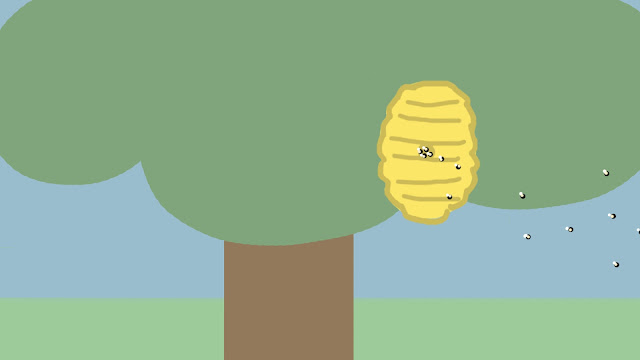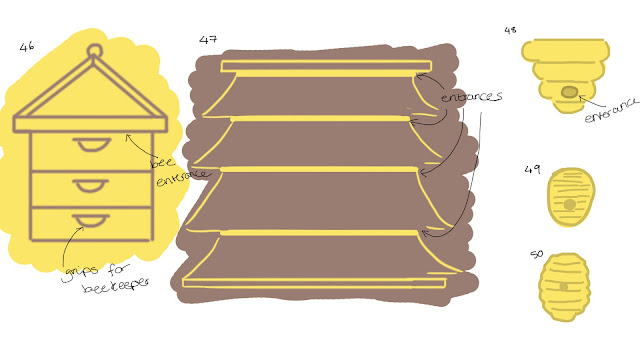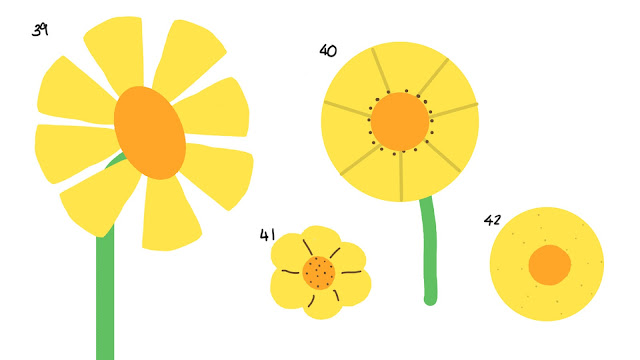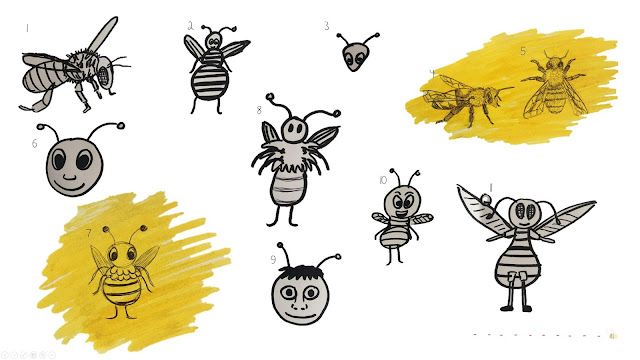Posts
Showing posts from March, 2018
@Phil Fantastic voyage - story idea
- Get link
- Other Apps
Story idea Collection of bees in the hive being briefed on their job for today by the queen bee Diagrams showing the sunflowers and how the bees are going to pollinate them - here is where I will show labelled diagrams of the flowers explaining what each part of the flower does and how the bees will help the flower's reproduction The bees are then assigned their own flower couple to help reproduce The bees are then released from the hive The bee that is being focused on (Buzz) then goes on a journey finding his flower couple using an image of the flowers As its his first time pollinating he gets confused with what to do so he looks around trying to see what the other bees are doing. A bee mentor then comes over and reminds him of what to do He then understands his job and pollinates them
Fantastic voyage - further research
- Get link
- Other Apps
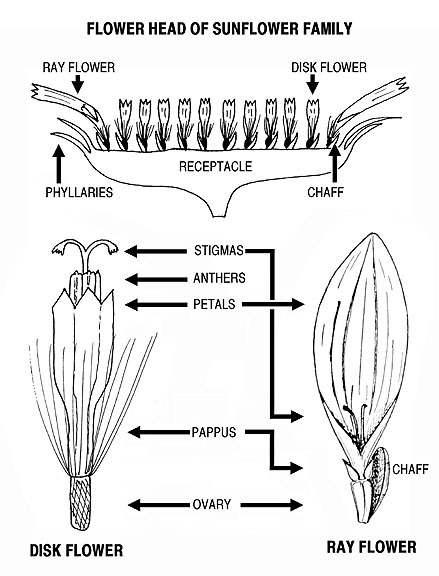
Insect pollination: Flower characteristics: Pollen is bigger, sticky or spikey to stick to insect bodies Stigma is sticky so that when insects brush past it, the pollen from them sticks to it The plants bear sticky, sweet nectar to attract insects Stamens are inside the flower so that insects will go into the flower, brush past the stamens and pick up the pollen The flower's p etals are brightly coloured and scented to attract insects Fertilisation : Pollen is transferred onto the stigma by insects or the wind A tube known as 'The pollen tube' begins to develop and grows through the style The pollen tube grows in the ovary, stopping at the ovule The nucleus (containing DNA/ genetic material) from the pollen travels down the pollen tube Pollen nucleus fuses with the nucleus of the ovule (fertilisation) The fertilised ovule, now called he zygote develops into a seed, then into a fruit At first, after looking at different flowers to use in the a
Life drawing - Lesson 17
- Get link
- Other Apps
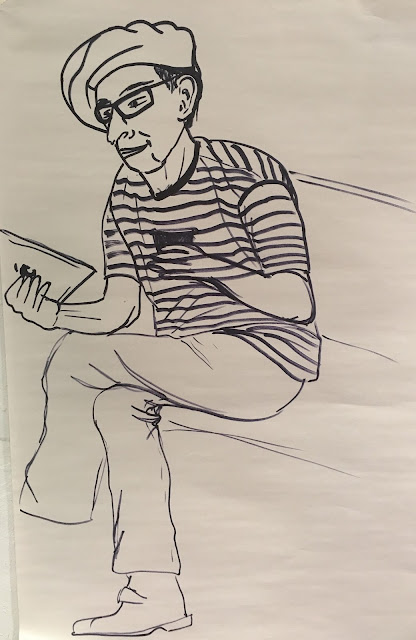
For our first exercise we were given 10 minutes to complete each of our drawings of our model acting as though he was taking the Metro. I used a marker pen to complete these drawings and the drawings that follow. For our next exercise we were given between 1 and 3 minutes to draw a variety of different poses of our model using props. For our final exercise we were given 8 minutes or so to complete a facial study of our model while he was wearing different props.
Fantastic voyage - flower research
- Get link
- Other Apps
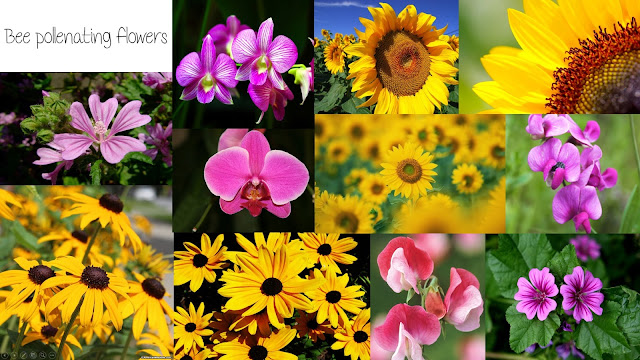
Here I have looked into different types of flowers bees pollinate and the different features that are common among them. I found that: The flowers are brightly coloured in order to attract the bees The centre of the flower is visible making it easy for the bees to reach its centre and collect the pollen from the flower's anther's (male reproductive organ) A lot of the flowers grow in groups or are surrounded by other flowers of the same type A lot of the flowers have leaves surrounding them
Fantastic voyage - Client research
- Get link
- Other Apps
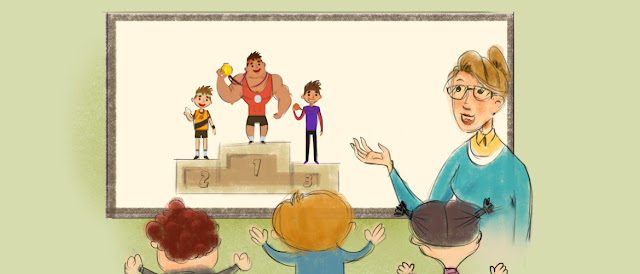
How animation is able to help students learn and retain information for longer periods of time While researching how animations are able to benefit students and their learning I came across this website: https://www.cgpundit.com/animation-in-education/ . It explains how using animation in the education of students have been proved to show that both the visual and verbal communication in animation has allowed for students to retain information for longer periods of time. This is as long as the animation is designed well and that the educational aspects are portrayed correctly. It also goes on to talk about how animation encourages feedback between students and further questions and communication between the students and teachers. The animation used in education can also effect the student's future and career path by either making the students more interested in the topic shown or by showing them what could be produced if they went into a creative career. The website also s
Soundscape - blog submission
- Get link
- Other Apps
Sonic concept publication Sound designer profile Original sound recordings Image 1 Image 2 Image 3 Reflective statement For this project we were given three images by Phil from which we were told to create sounds for. After being given the images I immediately started to bubble map ideas of what sounds or objects I believe relate to the images I was given. One of the first problems I encountered while doing this project was ensuring that the sounds special effects seemed to fit in with what I though the object in the image sounded like. In order to combat this I read through the notes we had been given from Kat's lessons and started to familiar myself even further with the software. I also struggled with recording sounds that I believed created a suitable sound for the image. For this, I researched further into different noises and what could be used to make them. I enjoyed being able to take my own spin on this project as w
Life drawing - Lesson 16
- Get link
- Other Apps
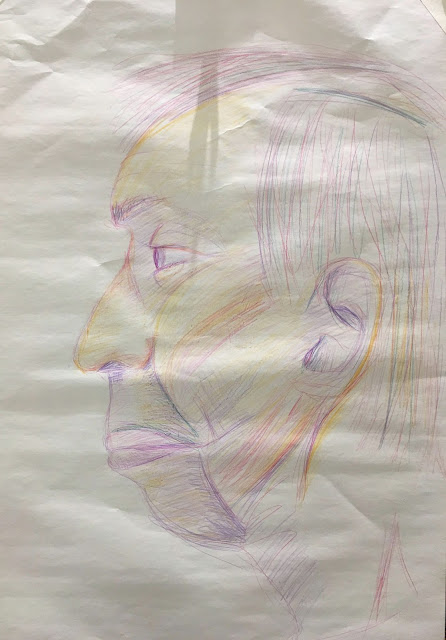
Here is the first image from our life drawing lesson. I decided to focus on the models face as I believe that human faces are one of my weaknesses. I used coloured pencils to complete this drawing. Here are my images from the second exercise that we did. Here we were given three minutes to draw the model while he went through the transition of being being a neanderthal to being a man. Here I used charcoal. This exercise was winter Olympics related so the model was pretending to ski, toboggan and play ice hockey. For this exercise I used bright green and pink pastels on black paper. For the final exercise I used a black marker pen to complete a face study of the model's face. I enjoyed doing this study.
Fantastic Voyage - Briefing and ideas
- Get link
- Other Apps
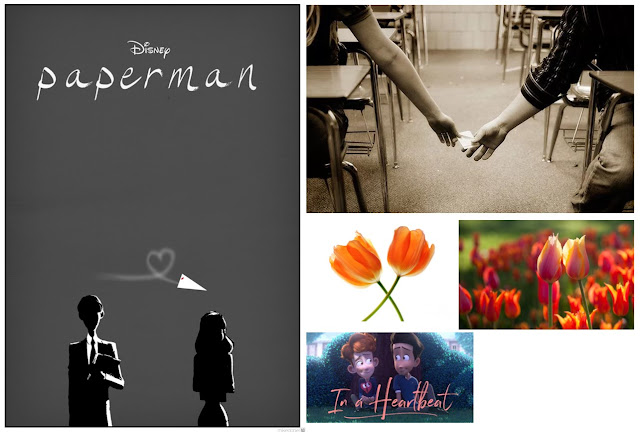
For our Fantastic Voyage briefing we were given three scenarios to choose from: The carbon cycle (GCSE Content, years 9 - 11) Plant growth cycles (Key Stage 3, years 7 - 8) The cardiac cycle (GCSE biology/ AS level biology, years 11 - 12) For one of the three scenarios above we have been told to create a 3 minute educational animation that can be used as a teaching resource for teachers to show to students. Out of the three scenarios I found the plant growth cycles to be the most interesting, especially insect pollination. In the briefing I found bee pollination to be the most renown way to pollinate so this is what I have decided to focus on. ------------------------------------------ Currently my main idea is that there is a romance between 2 flowers, but as they are distant from each other they are unable reproduce. This is until one day a bee flies by one of the flowers. This flower then asks the bee to pass some of his pollen to the other flower. The bee then
From script to screen - Reflective statement
- Get link
- Other Apps
For this project we were given the brief to create an animatic and pre-viz from the three components that we were to be given at the start of the project. My three components were pirate (for the character), hospital (for the location) and battery (as the object). One of the first problems that I encountered at the beginning of the project was that I was thinking too originally with the story ideas that I was presenting to Phil. For example one of my ideas was to have a surgeon who was dressed in a pirate fancy dress costume operating on a patient in order to give the patient a new pacemaker battery. Phil then said in my first OGR that I needed to go into depth with what each component could mean, for example, looking at different objects that could be seen as a battery, which has now helped me look at things differently for future projects. Another issue that I had faced was time management. At the start of the project I believed that I had done a suitable amount of work at each st
